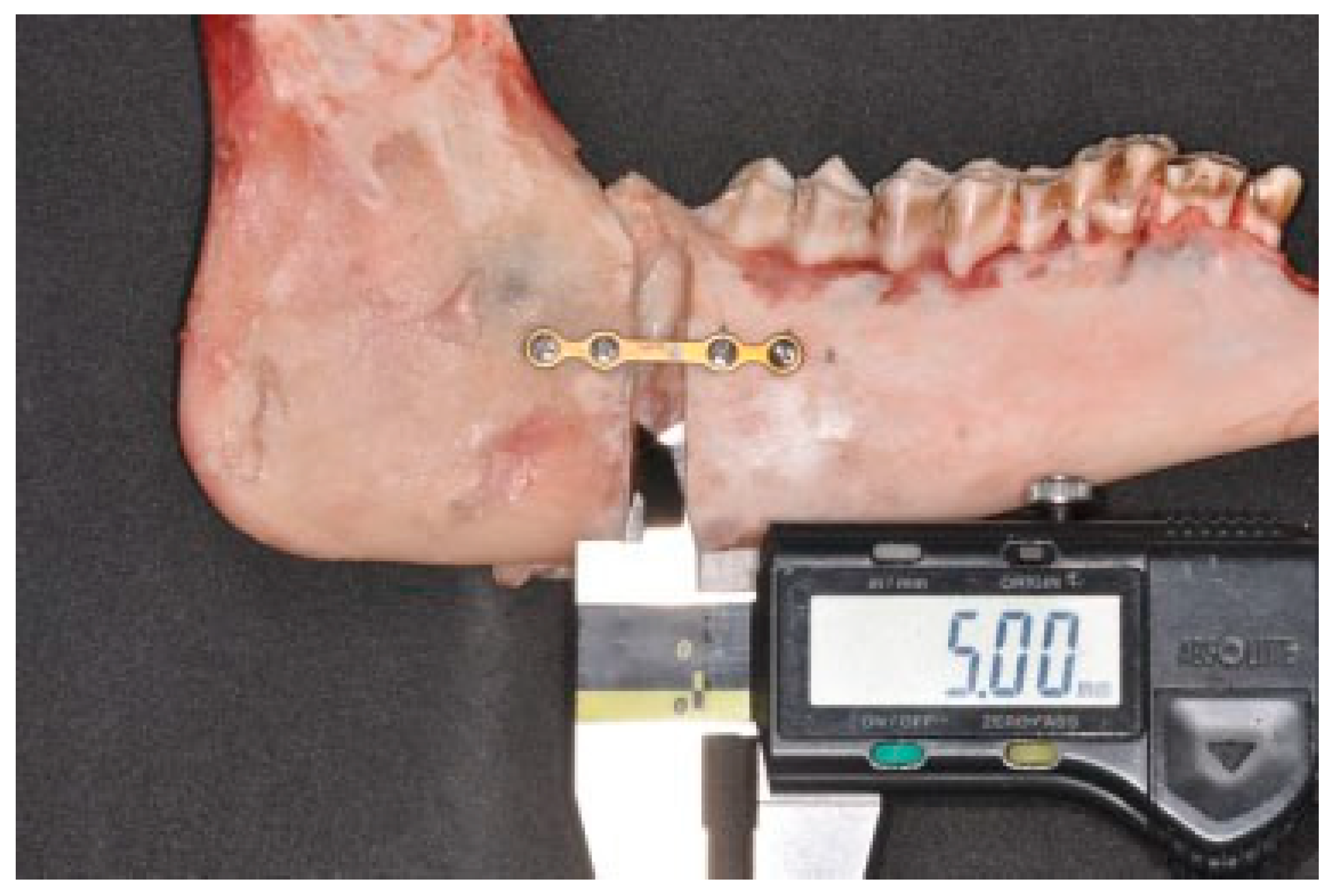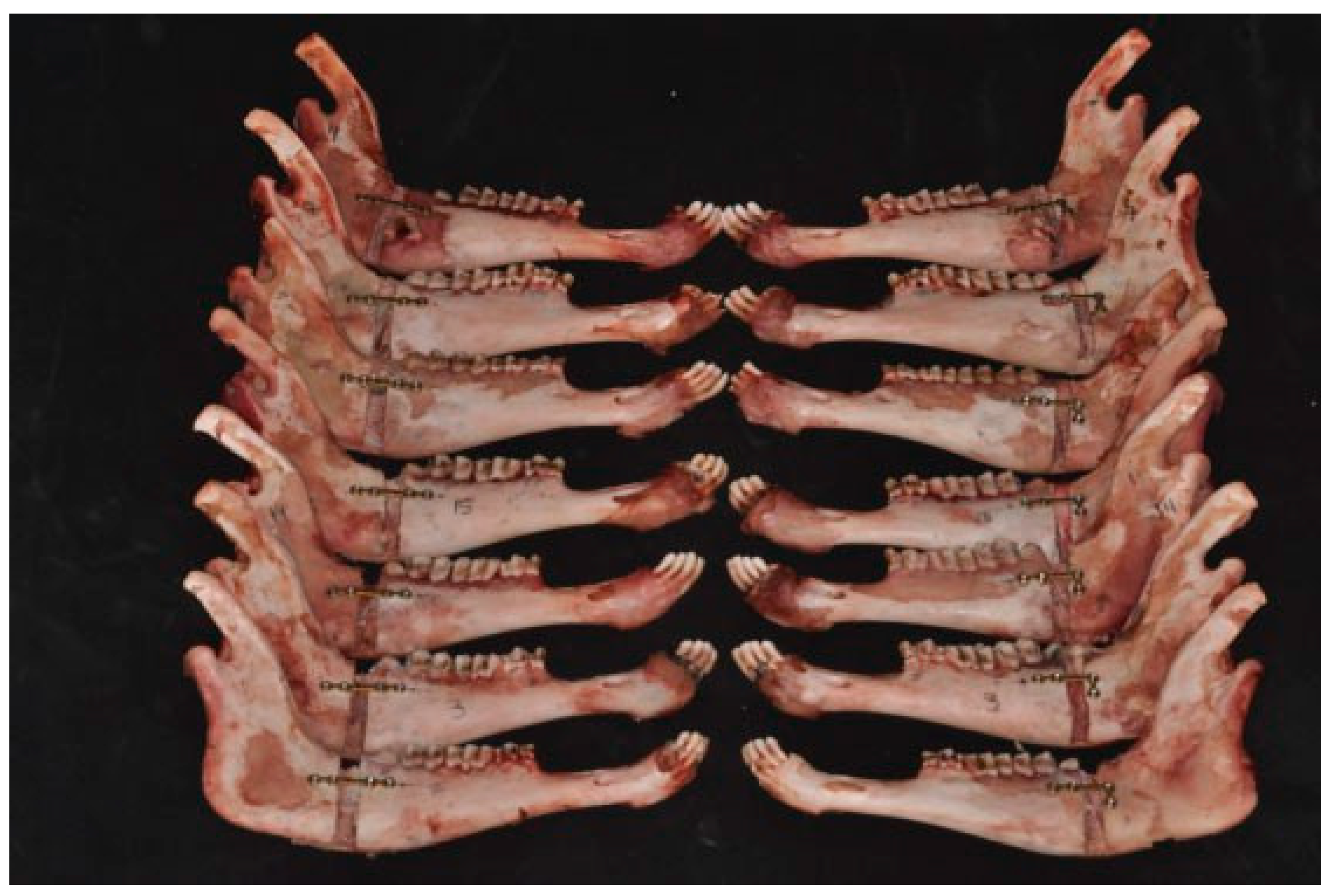Comparison of the Stability of Mandibular Sagittal Osteotomy Fixation between Two Types of Titanium Miniplates: A Biomechanical Study in Sheep Mandibles
Abstract
:Materials and Methods


Results
Discussion

| Sample | Maximum loading values (N) | Maximum displacement values (mm) | Loading values at the fracture (N) | |||
|---|---|---|---|---|---|---|
| Straight | L | Straight | L | Straight | L | |
| 1 | 112.36 | 69.79 | 68.01 | 76.18 | 6.20 | 48.76 |
| 2 | 91.32 | 83.21 | 73.78 | 64.35 | 37.45 | 83.17 |
| 3 | 59.62 | 51.84 | 45.54 | 72.50 | 43.22 | 33.05 |
| 4 | 54.14 | 48.72 | 84.33 | 73.32 | 33.40 | 48.72 |
| 5 | 58.36 | 77.32 | 72.64 | 73.01 | 9.18 | 77.17 |
| 6 | 62.04 | 74.10 | 57.01 | 61.45 | 7.60 | 28.51 |
| 7 | 56.93 | 146.60 | 42.22 | 73.04 | 46.74 | 57.96 |
| Maximum loading values (N) | Maximum displacement values (mm) | Loading values at the fracture (N) | pa | |
|---|---|---|---|---|
| Group I | 70.68 (22.26) | 63.36 (15.60) | 26.26 (17.91) | 0.05 |
| Group II | 78.80 (32.54) | 70.55 (5.42) | 53.91 (20.60) | 0.05 |
Conclusion
References
- Ribeiro-Junior, P.D.; Magro-Filho, O.; Shastri, K.A.; Papageorge, M.B. Which kind of miniplate to use in mandibular sagittal split osteotomy? An in vitro study. Int J Oral Maxillofac Surg 2012, 41, 1369–1373. [Google Scholar] [PubMed]
- Sato, F.R.; Asprino, L.; Noritomi, P.Y.; da Silva, J.V.; de Moraes, M. Comparison of five different fixation techniques of sagittal split ramus osteotomy using three-dimensional finite elements analysis. Int J Oral Maxillofac Surg 2012, 41, 934–941. [Google Scholar]
- Bell, W.H.; Schendel, S.A. Biologic basis for modification of the sagittal ramus split operation. J Oral Surg 1977, 35, 362–369. [Google Scholar] [PubMed]
- Epker, B.N. Modifications in the sagittal osteotomy of the mandible. J Oral Surg 1977, 35, 157–159. [Google Scholar] [PubMed]
- Wolford, L.M.; Bennett, M.A.; Rafferty, C.G. Modification of the mandibular ramus sagittal split osteotomy. Oral Surg Oral Med Oral Pathol 1987, 64, 146–155. [Google Scholar]
- Pereira Filho, V.A.; Iamashita, H.Y.; Monnazzi, M.S.; Gabrielli, M.F.; Vaz, L.G.; Passeri, L.A. In vitro biomechanical evaluation of sagittal split osteotomy fixation with a specifically designed miniplate. Int J Oral Maxillofac Surg 2013, 42, 316–320. [Google Scholar]
- Ueki, K.; Nakagawa, K.; Takatsuka, S.; Yamamoto, E. Plate fixation after mandibular osteotomy. Int J Oral Maxillofac Surg 2001, 30, 490–496. [Google Scholar]
- Ochs, M.W. Bicortical screw stabilization of sagittal split osteotomies. J Oral Maxillofac Surg 2003, 61, 1477–1484. [Google Scholar]
- McDonald, W.R.; Stoelinga, P.J.W.; Blijdorp, P.A. Rigid fixation after sagittal split osteotomies using Champy plates. Int J Adult Orthodon Orthognath Surg 1987, 2, 89. [Google Scholar]
- Aymach, Z.; Nei, H.; Kawamura, H.; Bell, W. Biomechanical evaluation of a T-shaped miniplate fixation of a modified sagittal split ramus osteotomy with buccal step, a new technique for mandibular orthognathic surgery. Oral Surg Oral Med Oral Pathol Oral Radiol Endod 2011, 111, 58–63. [Google Scholar]
- Joos, U. An adjustable bone fixation system for sagittal split ramus osteotomy: Preliminary report. Br J Oral Maxillofac Surg 1999, 37, 99–103. [Google Scholar] [PubMed]
- Gomes, P.P.; Guimarães Filho, R.; Mazzonetto, R. Evaluation of the bending strength of rigid internal fixation with absorbable and metallic screws in mandibular ramus sagittal split osteotomy: In vitro study. Pesqui Odontol Bras 2003, 17, 267–272. [Google Scholar]
- Ikemura, K.; Hidaka, H.; Etoh, T.; Kabata, K. Osteosynthesis in facial bone fractures using miniplates: Clinical and experimental studies. J Oral Maxillofac Surg 1988, 46, 10–14. [Google Scholar]
- Murphy, M.T.; Haug, R.H.; Barber, J.E. An in vitro comparison of the mechanical characteristics of three sagittal ramus osteotomy fixation techniques. J Oral Maxillofac Surg 1997, 55, 489–494, discussion 494–495. [Google Scholar]
- Bouwman, J.P.; Tuinzing, D.B.; Kostense, P.J. A comparative in vitro study on fixation of sagittal split osteotomies with Würzburg screws, Champy miniplates, and Biofix (biodegradable) rods. Int J Oral Maxillofac Surg 1994, 23, 46–48. [Google Scholar] [PubMed]
- Asprino, L.; Consani, S.; de Moraes, M. A comparative biomechanical evaluation of mandibular condyle fracture plating techniques. J Oral Maxillofac Surg 2006, 64, 452–456. [Google Scholar]
- Bosanquet, A.G.; Goss, A.N. The sheep as a model for temporomandibular joint surgery. Int J Oral Maxillofac Surg 1987, 16, 600–603. [Google Scholar]
- Özden, B.; Alkan, A.; Arici, S.; Erdem, E. In vitro comparison of biomechanical characteristics of sagittal split osteotomy fixation techniques. Int J Oral Maxillofac Surg 2006, 35, 837–841. [Google Scholar] [PubMed]
- Uckan, S.; Schwimmer, A.; Kummer, F.; Greenberg, A.M. Effect of the angle of the screw on the stability of the mandibular sagittal split ramus osteotomy: A study in sheep mandibles. Br J Oral Maxillofac Surg 2001, 39, 266–268. [Google Scholar]
- Abeloos, J.; De Clercq, C.; Neyt, L. Skeletal stability following miniplate fixation after bilateral sagittal split osteotomy for mandibular advancement. J Oral Maxillofac Surg 1993, 51, 366–369. [Google Scholar]
- Harada, K.; Watanabe, M.; Ohkura, K.; Enomoto, S. Measure of bite force and occlusal contact area before and after bilateral sagittal split ramus osteotomy of the mandible using a new pressure- sensitive device: A preliminary report. J Oral Maxillofac Surg 2000, 58, 370–373, discussion 373–374. [Google Scholar] [CrossRef] [PubMed]
- Tharanon, W. Comparison between the rigidity of bicortical screws and a miniplate for fixation of a mandibular setback after a simulated bilateral sagittal split osteotomy. J Oral Maxillofac Surg 1998, 56, 1055–1058. [Google Scholar] [CrossRef] [PubMed]
- Trulsson, M.; Johansson, R.S. Forces applied by the incisors and roles of periodontal afferents during food-holding and -biting tasks. Exp Brain Res 1996, 107, 486–496. [Google Scholar] [CrossRef] [PubMed]
- Moriya, T. Food biting behaviors with oral cavity sensation. Doctoral thesis, Tsukuba University, Graduate School of Systemic Information. January 2005. [Google Scholar]
© 2017 by the author. The Author(s) 2017.
Share and Cite
dos Santos Trento, G.; Pires, F.A.; dos Santos, F.A.; da Costa, D.J.; Rebellato, N.L.B.; Klüppel, L.E. Comparison of the Stability of Mandibular Sagittal Osteotomy Fixation between Two Types of Titanium Miniplates: A Biomechanical Study in Sheep Mandibles. Craniomaxillofac. Trauma Reconstr. 2018, 11, 114-117. https://doi.org/10.1055/s-0037-1603455
dos Santos Trento G, Pires FA, dos Santos FA, da Costa DJ, Rebellato NLB, Klüppel LE. Comparison of the Stability of Mandibular Sagittal Osteotomy Fixation between Two Types of Titanium Miniplates: A Biomechanical Study in Sheep Mandibles. Craniomaxillofacial Trauma & Reconstruction. 2018; 11(2):114-117. https://doi.org/10.1055/s-0037-1603455
Chicago/Turabian Styledos Santos Trento, Guilherme, Felipe Andrade Pires, Fábio André dos Santos, Delson João da Costa, Nelson Luis Barbosa Rebellato, and Leandro Eduardo Klüppel. 2018. "Comparison of the Stability of Mandibular Sagittal Osteotomy Fixation between Two Types of Titanium Miniplates: A Biomechanical Study in Sheep Mandibles" Craniomaxillofacial Trauma & Reconstruction 11, no. 2: 114-117. https://doi.org/10.1055/s-0037-1603455
APA Styledos Santos Trento, G., Pires, F. A., dos Santos, F. A., da Costa, D. J., Rebellato, N. L. B., & Klüppel, L. E. (2018). Comparison of the Stability of Mandibular Sagittal Osteotomy Fixation between Two Types of Titanium Miniplates: A Biomechanical Study in Sheep Mandibles. Craniomaxillofacial Trauma & Reconstruction, 11(2), 114-117. https://doi.org/10.1055/s-0037-1603455



